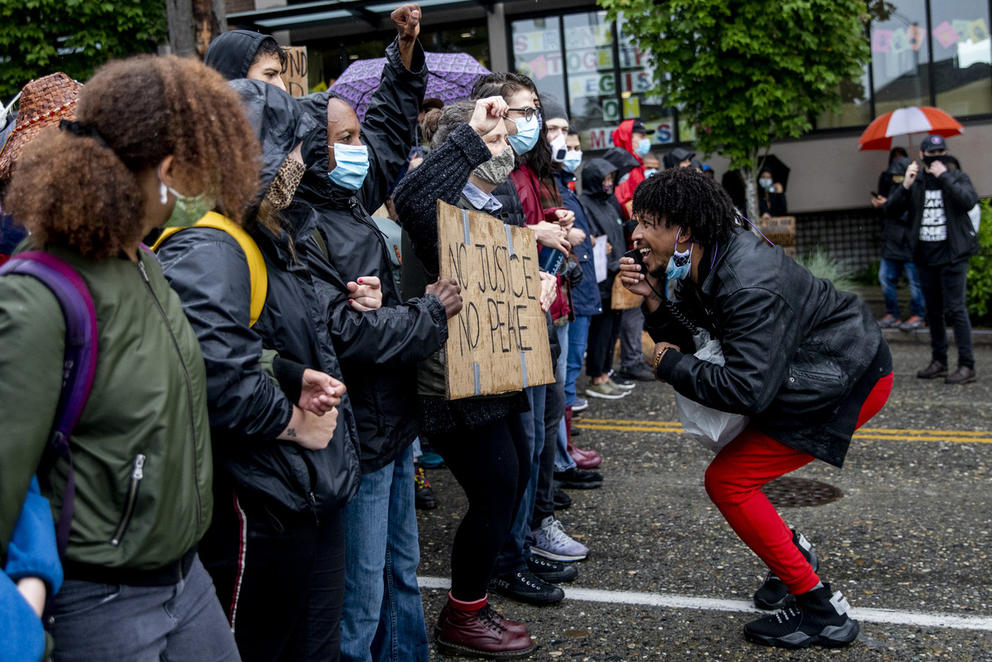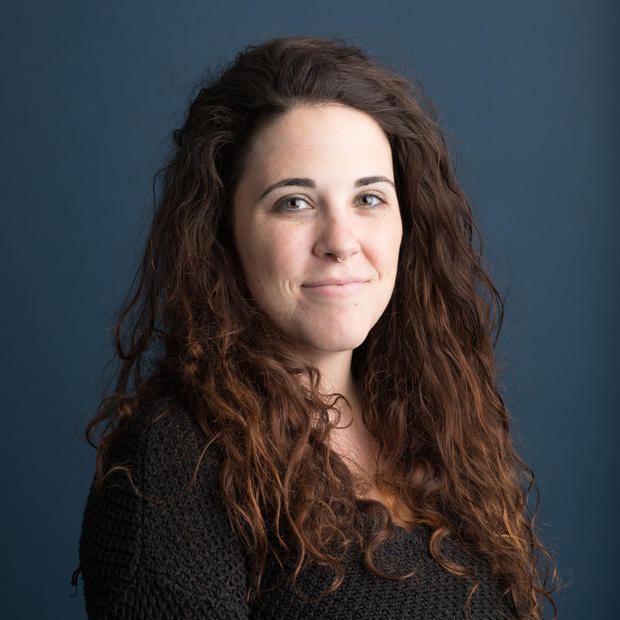“This is not just a movement for Capitol Hill,” Beverly said to the hundreds huddled together before the beginning of the almost 3-mile march. “This is not just a movement for 11th and Pine. This is the movement of a city.”
“And if you would like to say, white affluent people, that Black lives matter, then I need you to show Black lives matter,” Beverly continued. “We do not need words. We do not need company emails. We do not need fake posts. We do not need people with black screens on their social media. We need action.”
Beverly, 23, is part of an informal group of young Black leaders in Seattle who call themselves Engage. Leaders of Engage are determined to bring into the fold as many people as possible — from high school kids to older, white Americans —to push for change.
While much recent attention on the anti-racism protests has focused on CHOP, or Capitol Hill Organized/Occupied Protest, these Black leaders have largely directed their energy elsewhere, deliberately engaging with those they believe would be least likely to be part of a movement that centers on Black lives. Engage also aims to keep those already protesting amped up, actively brainstorming and looking out for one another. They know progress will take time and sustaining attention on the issue will take creativity.
Engage “keeps the action going and keeps people involved, and it keeps people energized during this time, because sometimes you can lose faith; you can lose hope,” said Garin PeyDay Peyton, a 29-year-old Black leader who helped steer the march to Madison Park through pouring rain, dancing and smiling the entire way.
“We get you involved, but we don't let you forget the message. We're not here to party. We're not here to have fun, but we're going to create that illusion,” Peyton said.
“If the kids aren't involved,” Peyton said, “there's no way we're going to be able to win this battle.”
In addition to marching, Engage has helped clean up schools in the region — picking up trash and pulling weeds — including at Washington Middle School and Garfield High School.
It also plans to hold a rally at Seattle City Hall and to camp outside of Mayor Jenny Durkan’s house.
“Hopefully, she'll come out and, if she's not there, then her neighbors will be aware and, you know, it's just another way to hold accountability for what's going on,” Peyton said.
Both Beverly and Peyton are music artists but didn’t know each other before getting involved in the Black Lives Matter movement. While Beverly grew up in various Seattle neighborhoods, Peyton said he’s lived in the city only for about 10 years, but now considers it home. Their families are supportive of their advocacy work.
Beverly said one reason he’s involved in the movement is because, like every other Black American, he’s developed tools for moving through society that shouldn’t be necessary.
Jason Beverly, 23, pauses before he addresses the crowd after marching from Cal Anderson Park to Madison Park Beach on June 12. He told the crowd that the location of Madison Park was picked intentionally. “We picked this location because it is occupied by wealthy affluent white people who are not engaged,” he told the marchers. “Black people do not feel comfortable and that is unacceptable. This is our city too.” (Dorothy Edwards/Crosscut)
“Being Black in this country means there are a lot of conversations that you have to have with yourself about how to navigate in this world, just personally, for your safety,” Beverly said. “I've had to have moments where I have a script, you know, ready to have conversations with the police.”
There’s “an entire country of people who are being mistreated,” he said.
Peyton, too, has had his own encounters with law enforcement. Although these interactions haven’t been positive, he knows too many other Black Americans have had worse experiences. The death of George Floyd is just one example of how run-ins can turn deadly.
“I've been dealing with this for my whole life,” Peyton said. “Being the kind of person I am, a button-up type of person ... you know, well-kept together kind of person, no matter what circumstance I'm in, it does kind of deter them from, you know, going the extra mile. But you know, it doesn't really stop them.”
Since the occurrence of protests spurred by Floyd's killing by Minneapolis police, both Beverly and Peyton said they’ve already seen white Seattleites become more aware of police brutality and the racism Black Americans face in their daily lives.
“It just seems people start to believe you a little bit more due to the fact that they've seen it on TV, or they've seen it on the internet,” Peyton said, referring to the video of former police officer Derek Chauvin pressing his knee into Floyd’s neck.
Peyton said he encountered one white woman who confessed her doubts about the movement because of what she had seen on the news regarding the protests, but she changed her perspective after stepping into a peaceful march led by him and others.
But not everyone has bought into the goals of the movement. Others have pushed back at their message and have even used racial slurs.
“We need to change the narrative of those situations,” Beverly said. “We see the Amy Coopers and we see, you know, all of these Karens, and we don't think about the people who were actually being hurt.”
Beverly said he hopes to counteract situations like these by focusing on the victim and the movement at large.
“That is a moment of trauma,” Beverly said. “We need to focus on uplifting those members of the community.”
On the Friday afternoon of the march, the rain disappeared and the sun surfaced as the activists reached Madison Park. Bill Withers’ 1970’s hit “Lovely Day” began to play. People started dancing.
But just as quickly as they celebrated, the conversation once again turned serious.
“Our lives are not tourism,” Beverly said, making it clear to others that their time outside wasn’t supposed to be like some miniversion of the music festival Coachella.
“This is about Black lives being taken,” he continued. “I shouldn’t have to worry about my goddamn outfit when I want to come to the park.
“That’s unacceptable because this is our city, too.”
With reporting by Dorothy Edwards












